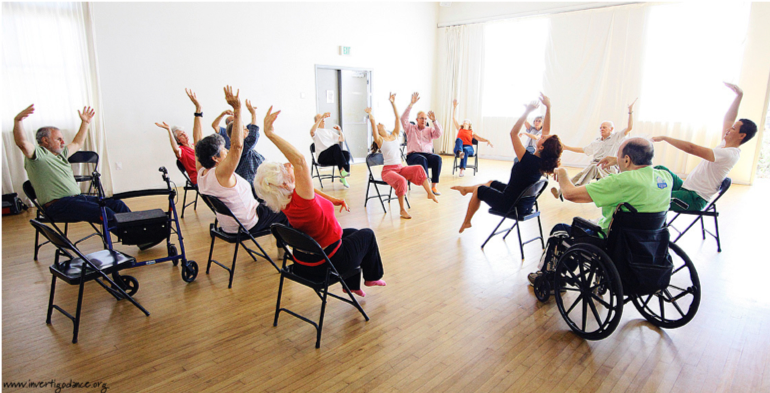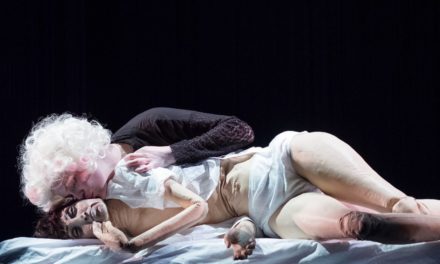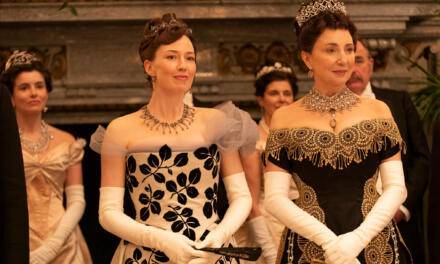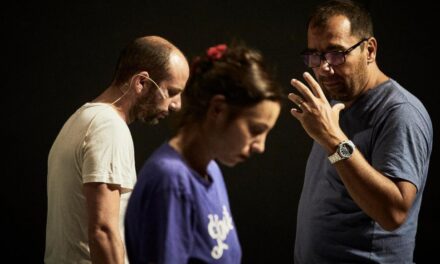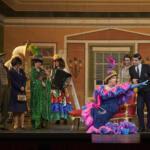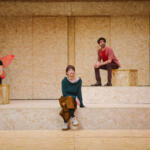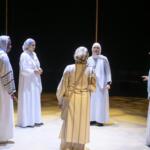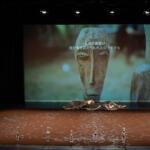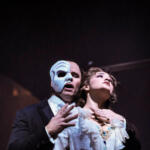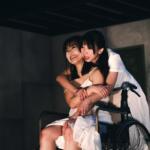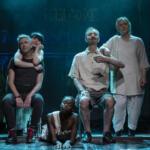Invertigo Dance Theatre is a provocative and passionate dance company based in Los Angeles. Laura Karlin is the artistic director of the company who works closely with her dancers to produce visually engaging and thought-provoking pieces. They have performed multiple shows, each with their own unique story structure. Laura graduated from Cornell University with a dual degree in choreography/production and civil rights. She founded Invertigo Dance Theatre in 2007 to create a space for storytelling. Invertigo has various outreach initiatives, such as their Invert/ED education program that provides dance opportunities for children of all ages and abilities. One of Invertigo’s most well-known outreach programs is the Dancing Through Parkinson’s community program, established in 2011. This class works to promote the physical and mental wellbeing of individuals suffering from Parkinson’s. However, everyone is encouraged to participate and benefit from dance.
I got the opportunity to speak with both Laura Karlin and Sofia Klass, one of the co-founders of the Dancing Through Parkinson’s program, to learn more about the company and how their work has impacted people’s lives. I was also able to attend and participate in one of the Dancing Through Parkinson’s classes where we learned the salsa. The energy and joy in the room was contagious and I can say first hand that it was not an easy class, yet the participants danced with determination and spirit.
What drew you towards dance theatre?
KARLIN: I have notebooks from when I was eight years old filled with choreography. I had stick figures, bird’s eye view, costume ideas, and concepts. I remember seeing these things in my head from an early age. The point was never bodies as architecture; the point was always somehow stories. I always had concepts or some kind of theatrically to them even as a kid.
In college, I did two majors, both independent interdisciplinary majors. My honors thesis was choreography and production where I created a full evening show. Comparing that work to my current work, looking back on it you can see the seeds or motifs of my work that just haven’t gone away. I am still teasing out these styles 18 years later, but they were definitely there. I learned a lot from having to produce my own show. I had to figure out marketing, box office, finding a stage manager, and scheduling dancers, which turned into a lot more of my life as the artistic director and choreographer of a company. These were skills I had to start developing.
I also lived in London for a year, my whole family is in the UK, and I really identified with the dance theatre movement that was going on there at the time. Choreographers such as Charlotte Vincent, Jasmine Bartaman, and Akram Khan (I studied with his company). People who were making work that really brought in elements of theatricality, some on a large scale and some on more intimate scales. All these companies were blending dance and theatre in a way I had not seen before. Intuitively it felt like what I was looking to do; it felt a lot like coming home.
How did this lead to you starting your own company?
KARLIN: I came back to LA in 2006 to work with the LA contemporary dance company and I stayed because I kept getting work as a choreographer and dance artist. A year being here, I felt there was a lot of space in the dance community to build something. As an artist, I didn’t want to wait for gatekeepers to say yes. I didn’t want to wait for people to give me permission to make the kind of work that I wanted to make. I felt that there was a small, but vibrant community here with a lot of possibilities and a lot of space. I wanted to make work that balanced accessibility, entertainment, being welcoming to audiences, while also being thought-provoking and challenging. I wanted to do that without being esoteric or alienating. That was the heart of why we started Invertigo. I also wanted to be able to start an institution beyond myself. I wanted something that lasted. There is a reason why it is not called Laura Karlin and dancers.
Do you think your degree in Civil Rights has influenced your work?
KARLIN: I think anything in the world can inspire and inform who one is as a leader, who one is as an artist, and simply whom one is as a person that exists in the world with as much compassion and progression as possible. First of all, I understand the fundamentals of certain legal issues, which is very helpful. I want to be clear that I did not go to law school, but it gave me a structure to understand social movements and social change. To understand how to question certain structures, specifically around queer theory and movements. I think that in some ways it gave me a language around certain issues that allowed me to deal with getting hate mail because I had a lesbian duet as part of a show. It gave me some rootedness. I am straight passing, but I am queer. I have been out since the eighth grade. But since I am married to a man, it is not something that people usually identify with me and that’s fine. As a culture, we didn’t have a language for these things.
Also, the degree gave me an academic ability to understand shifts in the way we think and talk about things. To understand the way issues are framed and that the language around these issues really matters. Also, my thesis was on hate crime legislation. Looking at how bodies—in this case, violence towards bodies in public spaces—affects our understanding of those bodies. As well as, how it forces some bodies into private spaces, because of the threat of public violence. While that might not seem directly applicable or parallel to the work that we do in dancing through Parkinson’s or some of the work I do performances; just some of the questioning around that led to better understanding of how to talk about bodies in public spaces in general and removing some of the hierarchy or roadblocks to true equity or inclusivity.
Could you tell me more about your Dancing Through Parkinson’s program and your inspiration in creating the program?
KARLIN: The program was founded by me, Linda Berghoff, and one of our dancers Sofia Klass. I was always interested in the mind-body connection and neurodegenerative diseases are an incredible part of that world. I wanted to understand and experience the mind-body connection. I was teaching yoga at the time and I wanted to study more about people with MS and Parkinson’s. But then Linda, who has been my other mother since I was a child, was diagnosed with Parkinson’s and had been for a few years at that point. Linda still takes more dance classes than I do in a week, but she was finding at the time that even the easier ones that she was going to, were feeling more difficult for her. So I was with her one day and asked her: what can we do together? Do you want to do yoga together? Do you want to dance together? Do you want to start a dance class together? Oh my god, we should start a dance class together! And it sort of went from there, we started scheming and dreaming what that would look like and what the values of that would be. For me, some of the most important principles are that it is a real dance class and is taught by professional dancers. It is not physical therapy or a support group. It is about community and joy, as much as it is about helping strengthen the mind-body connection and bolstering the physical side. At some point along the way we trained with the Mark Morris Dance Group that has Dance for PD, which is a very big structure now, but at the time they were just beginning their teacher trainings.
KLASS: Since then our teaching base has exploded. It has turned into this amazing program in six locations. Dance is about figuring out a movement puzzle and when you have Parkinson’s things that would seem automatically normal are no longer there for you anymore. You have to think things through just like you would in a dance. Where does my hip go, where are my feet, how connected to the floor am I, where is my head-tail connection? They are very related and circle around each other.

Photo Credits Invertigo Dance Theatre, Joe Lambie
How have your participants been affected by the class?
KARLIN: Just looking at the benefits of dance, which are strength, flexibility, balance, proprioception, all of these benefits, are things that would really help not just professional dancers, but also people with Parkinson’s or really anyone. We have a version of this program called Dancing Through Life, which is for anyone who doesn’t want to be in a dance class with a bunch of twenty-year-olds kicking their legs really high. I also think that creativity and the effect of being truly witnessed, so eye contact is really important. All of these things we were articulating in the beginning and have somewhat solidified over the past eight years. We’ve had a regular program going on for seven and a half years, but it was really eight years ago that we started putting it together.
KLASS: We know that it is important for people with Parkinson’s to move all the time and do complex movement where they have to learn new patterns constantly. It gets their neuro-synapses to fire quickly and making a certain level of neuroplasticity. However, that doesn’t necessarily drive the class; I think it is always there, but I think what we have created is a real dance class for people. We try to cover the basic dance class concepts: starting with a warm-up, then moving into arm work and footwork. Then we will shift into seated choreography giving the teacher a chance to keep warming the students up and bring in theatricality. It is very fun. This section has evolved a lot, it is more about telling a story now. In the warm-up I usually talk about the physicality of the body, waking up your joints, your limbs, your torso and then we get into more storytelling later. Which is closer to dance artistry. It has involved into more what Invertigo does which is storytelling and collaboratively making work. We will often ask our students to offer their own ideas to make community choreography.
Have you seen your students change over time?
KARLIN: I would say that we are careful about not making medical claims, although increasingly studies are backing up what we anecdotally do see often, which is people’s balance improves. Just within one class, we will see someone’s shoulders and chest open up.
KLASS: I have noticed from the student end, besides the fact that you see them walk in with one state and walk out better usually, sometimes tired, but they are much more confident about how they move. Not only can they get from A to B much easier because they know how to think through sequencing, but they also feel stronger. I had a student who had been in our class for a few years say that all of a sudden she realized that she no longer needed help getting out of the chair. It just dawned on her that she was physically stronger and she could just pop out of the chair while before she would need assistance. That was pretty exciting.
It sounds like an incredible class.
KARLIN: One of the things I want to make sure to mention, is one of the things that I hold very strongly about this program is the language around it and the philosophy informing that language. I want to make sure that we are non-hierarchal in the way we talk about movement options and physical abilities. We always have an equally fun and engaging seated option at all times. There are always modifications available depending on how someone is feeling in a day. We make sure not to present things as better or worse because it reinforces this very particular idea we have socially or as a society that there is a vertical spectrum of bodies.
I encourage you to look up Liz Lerman’s Hiking the Horizontal. She looks at the idea of how we structure our thoughts around movers. Professional athletes and dancers are at the top and then “normal people,” next is anyone with different body types, down to individuals with disabilities or who are differently abled, especially with neurodegenerative diseases. What she proposes doing is taking that vertical and making it a horizontal and then it’s a floor and everyone can dance on it together. That informs our philosophy behind this class. I am very careful about the language and a lot of teacher trainings include that. The teachers are professional dancers, they know how to teach a dance class, and so it is to make sure that they have that language.

Photo Credits Invertigo Dance Theatre, Joe Lambie
Your program mentions that everyone is welcome to come to the class regardless of diagnosis, but what do you think other individuals can get from participating in the class?
KARLIN: First off, dancing is good for everyone! You don’t need to have a Parkinson’s diagnosis to participate in the class or anything like that. These classes are really about bringing people into the room together to dance.
KLASS: We usually have two types of people that come without Parkinson’s, usually caregivers or family members and we also get individuals who are much older and just want to move. They all tend to get the same benefits: dance is a universal exercise of both your body and your brain.
KARLIN: They often come and say that they are just there to watch. I always say well if you are in the room you are dancing! I want to encourage them. It is amazing when they realize how fun the class is, but also how challenging it is. They have the opportunity to connect with their own bodies. I mean caregiving can be very stressful physically and emotionally. So they get this opportunity to connect with themselves. They are also reminded of how much their person can do. It is nice to see that happen, for them to realize their person is actually really capable.
KLASS: It is also social, and that is something that everyone gets a lot of, the social time. It is the time when they can connect with someone. This is incredibly important for the people in the community. We have one woman who is 93, she doesn’t have Parkinson’s, but she has come to our class since it has started. She is now the one that organizes all our parties and birthday celebrations. It is amazing because they have become a community. A community of friends who can relate to each other is a great feeling for them. It gives them help and strength to move forward. We also do intergenerational classes. Some of our students sometimes bring their grandchildren. That is always really fun, to have that young energy in the room.
This post was written by the author in their personal capacity.The opinions expressed in this article are the author’s own and do not reflect the view of The Theatre Times, their staff or collaborators.
This post was written by Elisa Rocha.
The views expressed here belong to the author and do not necessarily reflect our views and opinions.

